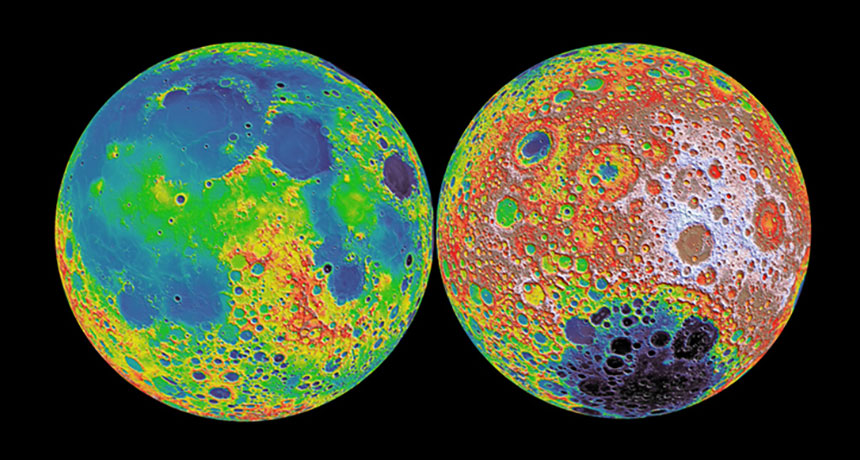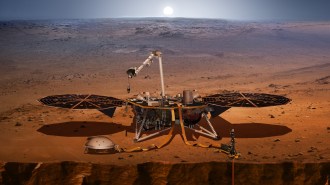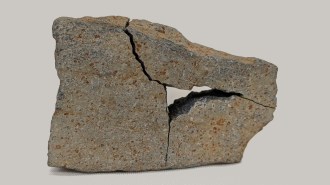The moon might have had a heavy metal atmosphere with supersonic winds
Radiation from an early Earth that glowed like a star would have vaporized metal to form air layer

ANCIENT ATMOSPHERE This false-color image shows high (red) and low (blue) terrains on the moon’s surface (near side, left; farside, right), which could preserve a record of the early lunar atmosphere.
NASA, GSFC, MIT, LOLA
- More than 2 years ago
The infant moon may have had a thick metal atmosphere, where supersonic winds raised waves in its magma ocean.
That’s the conclusion of a new simulation that calculates how heat from the young sun, the Earth and the moon’s own hot surface could have vaporized lunar metals to give the moon an atmosphere as thick as Mars’. The model, reported online June 22 at arXiv.org, offers a way to test theories of how the moon formed and suggests how researchers could study exoplanets without leaving Earth’s own neighborhood.
Most planetary scientists think the moon formed when a Mars-sized protoplanet slammed into the Earth around 4.5 billion years ago. The collision threw hot, molten material into Earth’s orbit, which coalesced and eventually cooled into the moon.
At first, though, the moon would have been covered in a deep, global ocean of hot liquid rock. The postcollision Earth would have been blisteringly hot as well — upwards of 2000° Celsius — and would have glowed like a red dwarf star.
Prabal Saxena of NASA’s Goddard Spaceflight Center in Greenbelt, Md., and colleagues added up the radiation the early moon would have received from that starlike Earth, plus the sun and the magma ocean itself. Previous models had suggested the early moon should have an atmosphere, but the team believes its model is the first to include all those inputs at once, revealing fresh details about how the atmosphere and ocean may have interacted.
All of that radiation would have vaporized volatile atoms in the metal-rich magma ocean and formed an atmosphere about one-tenth the thickness of Earth’s, the model showed. To keep things simple, the team used sodium — an easily vaporized element that is abundant on the moon — to represent all the components that could contribute to an atmosphere.
As long as the molten ocean remained liquid, the atmosphere would have received freshly vaporized sodium atoms from the ocean and sent them whipping through the metallic air. An extreme temperature difference — the side of the moon facing Earth would have been heated to temperatures greater than 1700° and the farside would have chilled to a frigid ‒150° — would have raised winds with speeds over a kilometer per second. The winds would probably have blown waves in the magma ocean.
When the winds reached the twilight zone between hot and cold, the atmosphere would have condensed, leaving a band of sodium snow.
After about 1,000 years, the magma ocean would have cooled enough to solidify into a rocky crust. Without a liquid reservoir to draw from, the entire atmosphere would have collapsed.
“The moon’s atmosphere was like a hard-partying rock star,” Saxena says. “It had a really violent, heavy metal existence, but it rapidly just fell apart.”
Kevin Zahnle of NASA’s Ames Research Center in Moffett Field, Calif., thinks this live fast, die young picture of the lunar atmosphere sounds plausible, and might be testable. “Their story is well within the bounds of the possible,” he says. But he’s not sure all of the model’s assumptions are good ones. Both Earth and the moon would have had to be “exceedingly dry” to avoid developing steamy water atmospheres first, for instance.
One way to test the model would be to look for a ring of extra sodium in the rocks around the transition zone. That would show that the atmosphere really did have an extreme temperature gradient and high winds.
Other models of the moon’s formation — for instance, if it formed from several small impacts instead of a single large one — would lead to a cooler atmosphere, less strong winds and ultimately no sodium snow, Saxena says. Finding that extra sodium could help settle the debate about which kind of impact really happened (SN: 4/15/17, p.18).
With its proximity to an Earth that glowed like a star, the early moon could also be a good analog for rocky exoplanets orbiting red dwarfs, Saxena says.
“If we can characterize what the early moon looked like, it can tell us about the physical mechanisms that are operating on these close-in extreme exoplanets,” Saxena says.







